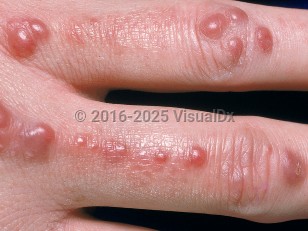Multicentric reticulohistiocytosis
Alerts and Notices
Important News & Links
Synopsis

Multicentric reticulohistiocytosis (MRH) is a rare disorder of unknown etiology that primarily affects the skin, mucous membranes, and joints. Typical onset is during the fourth decade of life, but individuals of any age can be affected. There is a predilection for females and people of Northern European descent. Joint involvement precedes cutaneous involvement in just over half of cases, with the onset of skin disease usually occurring 3 years after the onset of arthritis. Joint and skin disease present simultaneously in around one-fifth of patients, and skin disease precedes joint disease in another one-fifth.
In the skin, MRH appears as papules and/or nodules that most frequently occur on the acral areas of the body, especially the head, hands, and juxta-articular regions of the extremities. Mucous membrane involvement occurs in up to half of patients. The typical mucosal eruption is characterized by multiple erythematous papules and nodules that affect the oral and nasopharyngeal mucosa. Mucocutaneous disease typically lasts 5-10 years with subsequent regression.
Joint disease is a prominent feature of MRH that can produce significant morbidity. The typical presentation is a symmetric erosive polyarthritis that may evolve into arthritis mutilans. Progressive destruction of joints occurs in most individuals for about 6-8 years with stabilization thereafter. The distal interphalangeal (DIP) joints are affected most commonly (about 75% of cases), although any joint can be involved.
There are numerous reported associations including malignancy (up to 25%), tuberculosis (12%-50%), autoimmune disorders, and systemic vasculitis. Carcinomas of the lung, breast, stomach, cervix, ovary, and colon are the most frequently associated malignancies, although others have been reported.
In the skin, MRH appears as papules and/or nodules that most frequently occur on the acral areas of the body, especially the head, hands, and juxta-articular regions of the extremities. Mucous membrane involvement occurs in up to half of patients. The typical mucosal eruption is characterized by multiple erythematous papules and nodules that affect the oral and nasopharyngeal mucosa. Mucocutaneous disease typically lasts 5-10 years with subsequent regression.
Joint disease is a prominent feature of MRH that can produce significant morbidity. The typical presentation is a symmetric erosive polyarthritis that may evolve into arthritis mutilans. Progressive destruction of joints occurs in most individuals for about 6-8 years with stabilization thereafter. The distal interphalangeal (DIP) joints are affected most commonly (about 75% of cases), although any joint can be involved.
There are numerous reported associations including malignancy (up to 25%), tuberculosis (12%-50%), autoimmune disorders, and systemic vasculitis. Carcinomas of the lung, breast, stomach, cervix, ovary, and colon are the most frequently associated malignancies, although others have been reported.
Codes
ICD10CM:
E78.81 – Lipoid dermatoarthritis
SNOMEDCT:
84241008 – Multicentric reticulohistiocytosis
E78.81 – Lipoid dermatoarthritis
SNOMEDCT:
84241008 – Multicentric reticulohistiocytosis
Look For
Subscription Required
Diagnostic Pearls
Subscription Required
Differential Diagnosis & Pitfalls

To perform a comparison, select diagnoses from the classic differential
Subscription Required
Best Tests
Subscription Required
Management Pearls
Subscription Required
Therapy
Subscription Required
References
Subscription Required
Last Reviewed:10/24/2018
Last Updated:11/18/2018
Last Updated:11/18/2018
Multicentric reticulohistiocytosis

